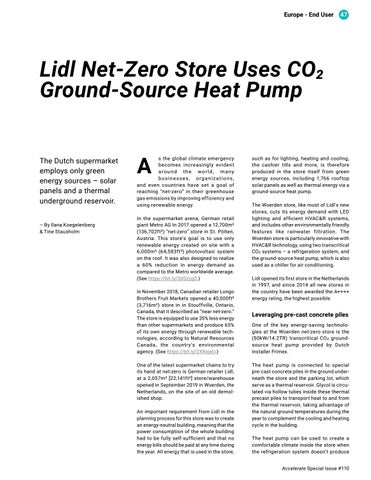Europe - End User
47
Lidl Net-Zero Store Uses CO2 Ground-Source Heat Pump The Dutch supermarket employs only green energy sources – solar panels and a thermal underground reservoir. – By Ilana Koegelenberg & Tine Stausholm
A
s the global climate emergency becomes increasingly evident around the world, many businesses, organizations, and even countries have set a goal of reaching “net-zero” in their greenhouse gas emissions by improving efficiency and using renewable energy. In the supermarket arena, German retail giant Metro AG In 2017 opened a 12,700m² (136,702ft²) “net-zero” store in St. Pölten, Austria. This store’s goal is to use only renewable energy created on site with a 6,000m² (64,583ft²) photovoltaic system on the roof. It was also designed to realize a 60% reduction in energy demand as compared to the Metro worldwide average. (See https://bit.ly/3dSzzqD.) In November 2018, Canadian retailer Longo Brothers Fruit Markets opened a 40,000ft² (3,716m²) store in in Stouffville, Ontario, Canada, that it described as “near net-zero.” The store is equipped to use 35% less energy than other supermarkets and produce 65% of its own energy through renewable technologies, according to Natural Resources Canada, the countr y’s environmental agency. (See https://bit.ly/2XNxjeU.) One of the latest supermarket chains to try its hand at net-zero is German retailer Lidl, at a 2,057m² [22,141ft²] store/warehouse opened in September 2019 in Woerden, the Netherlands, on the site of an old demolished shop. An important requirement from Lidl in the planning process for this store was to create an energy-neutral building, meaning that the power consumption of the whole building had to be fully self-sufficient and that no energy bills should be paid at any time during the year. All energy that is used in the store,
such as for lighting, heating and cooling, the cashier tills and more, is therefore produced in the store itself from green energy sources, including 1,766 rooftop solar panels as well as thermal energy via a ground-source heat pump. The Woerden store, like most of Lidl’s new stores, cuts its energy demand with LED lighting and efficient HVAC&R systems, and includes other environmentally friendly features like rainwater filtration. The Woerden store is particularly innovative with HVAC&R technology, using two transcritical CO2 systems – a refrigeration system, and the ground-source heat pump, which is also used as a chiller for air conditioning. Lidl opened its first store in the Netherlands in 1997, and since 2014 all new stores in the country have been awarded the A++++ energy rating, the highest possible.
Leveraging pre-cast concrete piles One of the key energy-saving technologies at the Woerden net-zero store is the (50kW/14.2TR) transcritical CO2 groundsource heat pump provided by Dutch installer Frimex. The heat pump is connected to special pre-cast concrete piles in the ground underneath the store and the parking lot, which serve as a thermal reservoir. Glycol is circulated via hollow tubes inside these thermal precast piles to transport heat to and from the thermal reservoir, taking advantage of the natural ground temperatures during the year to complement the cooling and heating cycle in the building. The heat pump can be used to create a comfortable climate inside the store when the refrigeration system doesn’t produce Accelerate Special Issue #110
